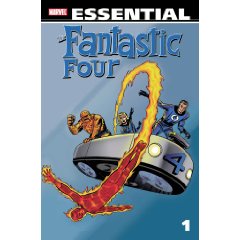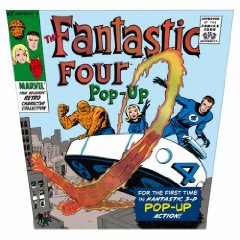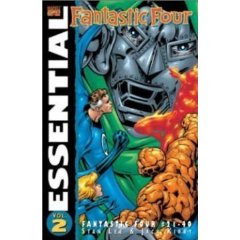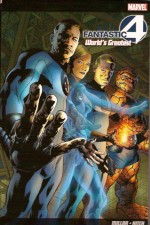
By Stan Lee, Jack Kirby & various (Marvel)
ISBN: 978-0-7851-3302-5
I love a bit of controversy so I’m going start off by saying that Fantastic Four #1 is the third most important American comicbook of the last sixty years, behind Showcase #4, which introduced the Flash and therefore the Silver Age, and The Brave and the Bold #28, which brought superhero teams back via the creation of the Justice League of America. Feel free to disagree…
After a troubled period at DC Comics (National Periodicals as it then was) and a creatively productive but disheartening time on the poisoned chalice of the Sky Masters newspaper strip (for details see our Complete Sky Masters of the Space Force review or better yet get your own copy – ISBN: 1-56685-009-6) Jack Kirby settled into his job at the small outfit that used to be the publishing powerhouse Timely/Atlas, churning out mystery, monster, romance and western material in a market he suspected to be ultimately doomed.
But his fertile imagination couldn’t be suppressed for long and when the JLA caught the reader’s attention it gave him and writer/editor Stan Lee an opportunity that changed the industry forever.
Depending upon who you believe a golfing afternoon led publisher Martin Goodman to order his nephew Stan to try a series about super-characters like the JLA, and the resulting team quickly took the industry and the fans by storm. It wasn’t the powers: they’d all been seen since the beginning of the medium. It wasn’t the costumes: they didn’t even have any until the third issue.
It was Kirby’s compelling art and the fact that these characters weren’t anodyne cardboard cutouts. In a real and recognizable location – New York City – imperfect, rather touchy people banded together out of tragedy and disaster to face the incredible.
In many ways The Challengers of the Unknown (Kirby’s prototype quartet is available in two wonderful DC Archives – ISBN’s 1-56389-997-3 and 1-4012-0153-9, as well as in a single economical, black and white compendium similar to this FF volume: ISBN13: 978-1-4012-1087-8) laid all the groundwork for the wonders to come, but the staid, almost hide-bound editorial strictures of National would never have allowed the, undiluted energy of the concept to run all-but unregulated.
Fantastic Four #1 (bi-monthly and cover-dated November 1961, by Lee, Kirby and an uncredited inker whose identity remains a topic of much debate to this day) is raw: rough, passionate and uncontrolled excitement, Thrill-hungry kids pounced on it.
‘The Fantastic Four’ saw maverick scientist Reed Richards summon his fiancé Sue Storm, their friend Ben Grimm and Sue’s teenaged brother before heading off on their first mission. They are all survivors of a private space-shot that went horribly wrong when Cosmic rays penetrated their ship’s inadequate shielding and mutated them all.
Richards’ body became elastic, Sue gained the power to turn invisible, Johnny Storm could turn into living flame and tragic Ben turned into a shambling, rocky freak. In ‘The Fantastic Four meet the Mole Man’ they foil a plan by another outcast who controls monsters and slave humanoids from far beneath the Earth. This summation of the admittedly mediocre plot cannot do justice to the engrossing wonder of that breakthrough issue – we really have no awareness today of how different in tone, how shocking it all was.
“Different” doesn’t mean “better” even here, but the FF was like no other comic on the market at the time and buyers responded to it hungrily. The brash experiment continued with another old plot in #2. ‘The Skrulls from Outer Space’ were shape-changing aliens who framed the FF before the genius of Mister Fantastic bluffed them into abandoning their plans for conquering Earth.
Issue #3, with inks by Sol Brodsky, featured ‘the Menace of the Miracle Man’ whose omnipotent powers had a simple secret, but is more notable for the first appearance of their uniforms, and a shocking line-up change, which lead directly into the next issue (continued stories were an innovation in themselves) which revived a golden-age great.
‘The Coming of the Sub-Mariner’ reintroduced the all-powerful amphibian Prince of Atlantis, who had been lost for decades, a victim of amnesia. Recovering his memory thanks to the Human Torch, Namor returned to his sub-sea home only to find it destroyed by atomic testing. A monarch without subjects, he swore vengeance on humanity and attacked New York City with a gigantic monster. This saga is when the series truly kicked into high-gear…
Until now the creative team, who had been in the business since it began, had been hedging their bets. Despite the innovations of a contemporary superhero experiment their antagonists had relied heavily on the trappings of popular trends in the media – and as reflected in their other titles. Aliens and especially monsters played a major part in the earlier tales but Fantastic Four #5 took a full-bite out of the fight n’ tights apple and introduced the first full-blown super-villain to the budding Marvel Universe.
No, I haven’t forgotten Mole Man: but that tragic little gargoyle, for all his plans of world conquest wouldn’t truly acquire the persona of a costumed foe until his more refined second appearance in #22.
‘Prisoners of Doctor Doom’ (July 1962, and inked by the subtly slick Joe Sinnott) has it all. An attack by a mysterious enemy from Reed’s past, magic and super-science, lost treasure, time-travel – even pirates. Ha-haar, me ‘earties!
Sheer magic! And the creators knew they were on to a winner as the deadly Doctor returned the very next issue, teamed with a reluctant Sub-Mariner to attack our heroes as ‘The Deadly Duo!’ inked by new regular embellisher Dick Ayers.
Alien kidnappers were the motivating force when the team became ‘Prisoners of Kurrgo, Master of Planet X’, a dark and grandiose off-world thriller in FF#7 (the first monthly issue), and a new villain plus the introduction of a love-interest for the monstrous Ben Grimm were the breakthrough high-points in #8: ‘Prisoners of the Puppet Master!’
The December issue, #9, trumpeted ‘The End of the Fantastic Four’ as the Sub-Mariner returned to exploit another brilliant innovation in comic storytelling. When had a super-genius, superhero ever messed up so much that the team had to declare bankruptcy? When had costumed crimefighters ever had money troubles at all? The eerily prescient solution was to “sell out” and make a blockbuster movie – giving Kirby a rare chance to demonstrate his talent for caricature…
1963 was a pivotal year in the development of Marvel. Lee and Kirby had proved that their new high concept -human heroes with flaws and tempers – had a willing audience. Now they would extend that concept to a new pantheon of heroes. Here is where the second innovation would come to the fore.
Previously, super-heroes were sufficient unto themselves and shared adventures were rare. Here, however was a universe where characters often tripped over each other, sometimes even fighting each other’s enemies! The creators themselves might turn even up in a Marvel Comic! Fantastic Four #10 featured ‘The Return of Doctor Doom!’ wherein the arch villain used Stan and Jack to lure the Richards into a trap where his mind is switched with the bad Doctor’s.
The innovations continued. Issue #11 had two short stories instead of the usual book-length yarn; ‘A Visit with the Fantastic Four’ and ‘The Impossible Man’, with a behind-the-scenes travelogue and a baddie-free, compelling, comedic tale. FF #12 featured an early crossover as the team were asked to help the US army capture ‘The Incredible Hulk’.
This was followed by ‘Versus the Red Ghost and his Incredible Super Apes!’ a cold war thriller pitting them against a soviet scientist in the race to reach the Moon: a tale notable both for the moody Steve Ditko inking (replacing the adroit Ayers for one month) of Kirby’s artwork and the introduction of the cosmic voyeurs called The Watchers.
Issue #14 featured the return of ‘The Sub-Mariner and the Merciless Puppet Master!’ and was followed by ‘The Mad Thinker and his Awesome Android!’ a chilling war of intellects with plenty of room for all-out action. FF #16 revealed ‘The Micro-World of Doctor Doom!’ in a spectacular romp guest-starring new hero Ant-Man, yet the villain promptly returned with infallible, deadly traps next month in ‘Defeated by Doctor Doom!’
A shape-changing alien with all their powers was next to menace our heroes when ‘A Skrull Walks Among Us!’ and issue #19 introduced another of the company’s top-ranking super-villains as the FF became ‘Prisoners of the Pharaoh!’ This time travel tale has been revisited by so many writers that it is considered one of the key stories in Marvel history.
Fantastic Four #20 introduced ‘The Mysterious Molecule Man!’ and the next guest-starred Nick Fury (fresh from his own World War II comicbook and soon to be the company’s answer to James Bond) to battle ‘The Hate-Monger!’ (inked by veteran George Roussos, using the protective nom de plume George Bell).
The rest of this terrific book is taken up with reprinting the first summer Annual: a spectacular thirty-seven page epic battle as, reunited with their wandering prince the warriors of Atlantis invaded New York City, and presumably the rest of the world, in ‘The Sub-Mariner versus the Human Race!’.
Also included is the charming short tale ‘The Fabulous Fantastic Four meet Spider-Man!’, a re-interpretation of the first meeting between the two most popular Marvel brands from the premiere issue of the wall-crawlers own comic. Pencilled this time by Kirby, Ditko once more applied his unique inking for a truly novel look. To close out the book there’s also a large selection of pin-ups and information pages illustrated by Kirby and chums to accompany earlier pages that dot the book and even the un-used, alternative cover for the annual.
Although possibly – just, perhaps – a little dated in tone, these are still classics of comic story-telling illustrated by one of the world’s greatest talents just approaching his mature peak. They are fast, frantic fun and a joy to read or re-read. This comprehensive, joyous introduction (or even reintroduction) to these characters is a wonderful reminder of just how good comic books can – and should be.
© 1961, 1962, 1963, 2008 Marvel Characters, Inc. All Rights Reserved.




